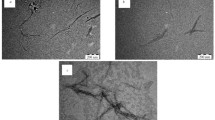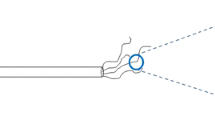Abstract
The conductivity of microcrystalline cellulose (MCC) dispersions in aqueous 10–5–10–2 M HCl and NaOH solutions was measured as a function of the particle volume fraction by the conductometry. The dependence of the relative conductivity of MCC particles on pH of equilibrium solutions was determined using the Wagner equation. The electrophoretic mobility of MCC particles in the aforementioned solutions was measured by the microelectrophoresis, and corresponding dependences of the particle ζ potentials on pH of aqueous HCl and NaOH solutions (pH 2–11) were calculated using the Smoluchowski and Henry equations of the electrophoresis theory. It was shown that, in the case of MCC, the Henry equation, which allows for the significant conductivity of the dispersed particles, as compared with the dispersion medium, makes it possible to calculate more accurate ζ potential values and, consequently, to derive the ζ(pH) dependence, which is satisfactorily consistent with the effect of the surface charge and solution ionic strength on the ζ potential in a wide pH range.
Similar content being viewed by others
REFERENCES
Kaputskii, F.N. and Yurshkovich, T.L., Lekarstvennye preparaty na osnove proizvodnykh tsellyulozy (Drug Preparations Based on Cellulose Derivatives), Minsk: Universitetskoe, 1989.
Clark, J., Tekhnologiya Tsellyulosy (Cellulose Technology), Moscow: Lesnaya Prom-st', 1983.
Schemp, W., Philipp, B., and Steege, H.H., Papier, 1976, vol. 3, no. 12, p. 501.
Matsuzaki, K. and Uda, K., Sen'i Gakkaishi, 1982, vol. 38, no. 3, p. 40.
Jeevananda, T. and Siddaramaiah, I., Indian J. Eng. Mater. Sci., 1997, vol. 4, no. 1, p. 4.
Beduneau, H., Rev. Prod. Chem., 1964, vol. 67, no. 1321, p. 241.
Belyakov, N.A. and Korol'kova, S.V., Adsorbenty. Katalog-spravochnik (Adsorbents. A Catalog-Handbook), St. Petersburg: MAPO, 1997.
Battista, O.A. and Smith, P.A., Ind. Eng. Chem., 1962, vol. 54, no. 9, p. 20.
Thomas, W.R., Prog. Food Nutr. Sci., 1982, vol. 6, no. 1, p. 341.
Sanderson, G.R., Food Technol. (Chicago), 1981, vol. 35, no. 7, p. 50.
William, T., Food Manuf., 1979, vol. 54, no. 1, p. 30.
Peleg, M. and Hollenbach, A.M., Food Technol. (Chicago), 1984, vol. 38, no. 3, p. 93.
Asatov, S.I., Ussubaev, M.U., and Ussubaev, A.M., Khim. Prir. Soedin., 2000, Spec. issue, p. 62.
Shoikulov, B.B., Nabiev, D.S., Mirzakhidov, Kh.A., et al., Khim. Prir. Soedin., 1999, no. 5, p. 577.
Di Memmo, L.M., Agylirah, G.A., and Wheatley, A., Scanning, 1996, vol. 18, no. 3, p. 236.
Kazuhiro, O., Kobunshi Ronbunshu, 1999, vol. 56, no. 3, p. 141.
Vinogradova, L.I., Mel'chakova, N.A., Sharkov, V.V., et al., Khimiya i tekhnologiya bumagi (Paper Chemistry and Technology), Leningrad: LTA, 1983, p. 87.
Petropavlovskii, G.A. and Kotel'nikova, N.E., Khim. Drev., 1979, no. 6, p. 3.
Plonka, A., Przegl. Papier, 1981, vol. 37, no. 6, p. 228.
Paquot, M., Wiss. Technol., 1982, vol. 15, no. 3, p. 148.
Scallan, A.M., TAPPI J., 1989, no. 1, p. 157.
Been, J. and Oleman, C.W., J. Pulp Pap. Sci., 1995, vol. 21, no. 3, p. 80.
Van De Ven, T.G.M., J. Pulp Pap. Sci., 1999, vol. 25, no. 7, p. 243.
Sidorova, M.P., Ermakova, L.E., Kotel'nikova, N.E., and Kudina, N.P., Kolloidn. Zh., 2001, vol. 63, no. 1, p. 106.
Hunter, R.J., Zeta Potential in Colloid Science. Principles and Applications, London: Academic, 1981.
Yur'ev, V.I., Poverkhnostnye svoistva tsellyuloznykh voloknistykh materialov (Surface Properties of Cellulosic Fibrous Materials), Khimiya, 1996.
Grigorov, O.N., Karpova, I.F., et al., Rukovodstvo k prakticheskim rabotam po kolloidnoi khimii (Laboratory Manual on Colloid Chemistry), Moscow: Khimiya, 1964.
Wagner, K.W., Die Isolierstoffe der Elektrotechnik, Berlin: Springer-Verlag, 1924.
Author information
Authors and Affiliations
Rights and permissions
About this article
Cite this article
Zhukov, A.N., Baturenko, D.Y., Chernoberezhskii, Y.M. et al. Conductivity and Electrokinetic Potential of Microcrystalline Cellulose Particles in Aqueous HCl and NaOH Solutions. Colloid Journal 65, 310–313 (2003). https://doi.org/10.1023/A:1024250621693
Issue Date:
DOI: https://doi.org/10.1023/A:1024250621693




